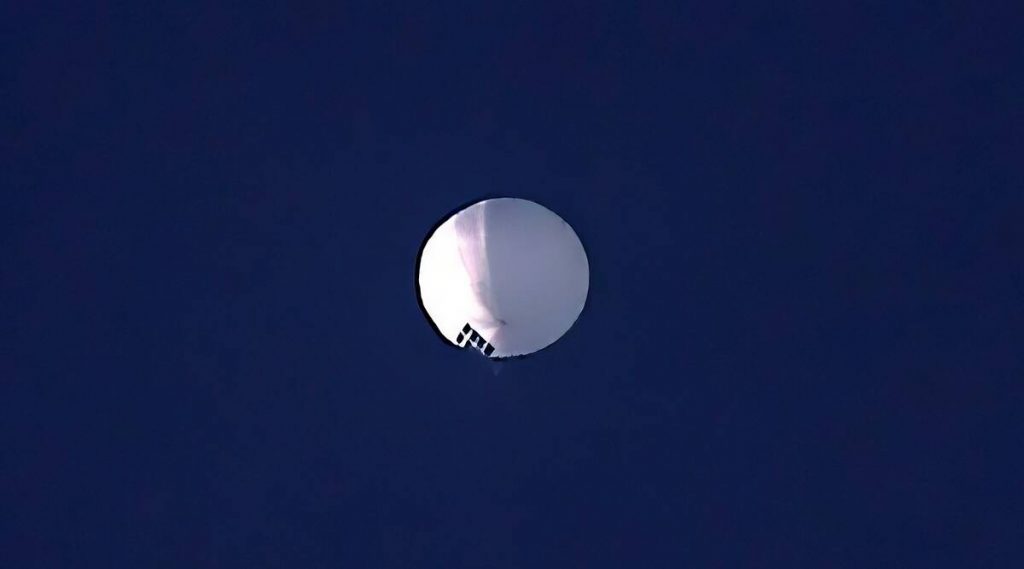Secretary of State Antony Blinken on Friday cancelled a weekend trip to Beijing after a chinese spy balloon was sighted above the rocky mountain state of montana , igniting a frenzy of media coverage and political commentary over a machine that the Pentagon said posed no threat to the United States.
Blinken called the Chinese surveillance an “irresponsible act” and a “clear violation of US sovereignty and international law.”
China’s “decision to take this action on the eve of my planned visit is detrimental to the substantive discussions that we were prepared to have,” he said at a news conference Friday afternoon.
Blinken cancelled the trip after civilians in Montana this week began spotting the balloon, which the Pentagon said was an “intelligence-gathering” airship. Military officials had been monitoring the balloon for days, and Blinken and a deputy secretly confronted Chinese diplomats in Washington on Wednesday. But it became a diplomatic crisis only as media attention mounted on Thursday night and Republican politicians called for President Joe Biden and Blinken to act.
The balloon’s presence and Blinken’s announcement added to the rising tensions between the two superpowers. The situation also underscored the sensitive politics in the United States as both Democratic and Republican leaders vie to be seen as sufficiently hawkish on China.
Blinken had planned to leave Friday night for the trip, the first visit by a US secretary of state to China since 2018. He had been expected to meet with President Xi Jinping and discuss a wide range of issues. But Blinken said he called Wang Yi, China’s top foreign policy official, on Friday and said he was postponing his trip because of the balloon.
Blinken said he told Wang he would visit China “when conditions allow.”
Some Republican lawmakers criticised President Joe Biden on Thursday for allowing the balloon to drift for days over the United States and not taking harsher measures against China. White House officials said such balloons have appeared over US territory before, including during the Trump administration.
By midday Friday the balloon had reached Kansas, where it was sometimes hovering and sometimes moving at speeds of up to 70 mph, Pentagon officials said. The United States was using its own surveillance methods to monitor and study the machine, including deploying aircraft.
Biden may yet decide to shoot it down, a Pentagon official said, but he will likely not do so until the balloon is above water, probably over the Atlantic Ocean, given the southeasterly direction it has been heading.
“Right now, we assess that there is no threat, no physical threat or military threat, to people on the ground,” Brig. Gen. Pat Ryder, a Pentagon spokesperson, said Friday.
Blinken and Wendy Sherman, deputy secretary of state, spoke with the Chinese Embassy on Wednesday night about the balloon, and American diplomats in Beijing confronted Chinese officials there, State Department officials said. They and Pentagon officials spoke on the condition of anonymity because of the sensitivities over the balloon.
Pentagon officials said that while other surveillance balloons have hovered over the United States in recent years, this one has lingered longer than any previous ones.
The Chinese government expressed its regret over the incident and asserted that the balloon was for civilian research and had “deviated far from its planned course.” The statement appeared to be an effort to keep Blinken’s visit on track.
Chinese officials had been anticipating the visit as an important moment to mark China’s reopening to the world after Xi decided in December to end his “zero Covid” policy, which had led to protests last fall and worsened an economic slowdown. Planning for the trip began after Xi met with Biden on the sidelines of a Group of 20 summit in Bali, Indonesia, in November.
Both the Trump and Biden administrations have adopted a combative stance toward China, saying that the Chinese Communist Party is intent on undermining the US-led world order. Biden has greatly expanded efforts to hobble China’s technological advancements. And he has worked with allies and partners across Asia, including with Taiwan, the de facto independent island that China claims, to bolster military forces in the event of an armed conflict with China.
On Thursday, Defense Secretary Lloyd Austin said in Manila that the US military would begin using as many as nine bases across the Philippines for temporary housing of troops and equipment, a move aimed at deterring China from trying to invade Taiwan or take further military action in the South China Sea.
Biden administration officials are sensitive to any suggestions that they are not taking a hard line against China. But Blinken insisted Friday that national security concerns and not domestic politics were the reasons behind his decision to cancel the trip.
Republican officials laid out various demands of Blinken after news of the balloon emerged on Thursday.
A post on the official Twitter account of Republican lawmakers on the House Foreign Affairs Committee, chaired by Rep. Michael McCaul, R-Texas, said it was “imperative” that Blinken tell Xi and his government that “their military adventurism will no longer be tolerated.” Sen. Tom Cotton, R-Ark., wrote online that Blinken should cancel his trip.
Biden is scheduled to give his annual State of the Union speech in Congress on Tuesday.
Jessica Chen Weiss, a political scientist at Cornell University who recently worked in the State Department on China policy, said the decision to cancel Blinken’s trip “reflects the unfortunate triumph of symbolism over substance.”
“It also confirms the low expectations going into the trip, that the potential upside should have been so outweighed by the domestic political risks of visiting Beijing amid congressional outrage,” she said.
Daniel Russel, a former assistant secretary of state for East Asia and the Pacific and a vice president at the Asia Society Policy Institute, said “the administration clearly was dissatisfied with the Chinese government’s public expression of regret — perhaps because Beijing insisted on hiding behind the laughable alibi that this was a weather balloon blown off course.”
“This incident has soured the atmosphere and hardened positions, and there’s no guarantee the two sides can successfully resurrect the Bali momentum,” he added.
Pentagon spokesperson Brig. Gen. Patrick Ryder said that the public has the ability to look up in the sky and see where the alleged Chinese spy balloon is when questioned about whether the location of the balloon was classified pic twitter.com/Z8JXt4HzYo
— Reuters (@Reuters) February 4,2023
The explanation from the Chinese Foreign Ministry came after Pentagon officials said Thursday that they had detected a balloon, “most certainly launched by the People’s Republic of China,” over Montana, which is home to about 150 intercontinental ballistic missile silos.
After initially telling reporters it had to check on the claims about the balloon, the ministry said late Friday in Beijing that the balloon’s course was an accident.
“The airship is from China. It is a civilian airship used for research, mainly meteorological, purposes,” an unidentified spokesperson for the ministry said in a statement on its website. “Affected by the Westerlies and with limited self-steering capability, the airship deviated far from its planned course. The Chinese side regrets the unintended entry of the airship into US airspace due to force majeure.”
“Force majeure” refers to a violation caused by forces beyond a party’s control.
The ministry said it would talk with US officials about how to “properly handle this unexpected situation.”
“It’s a plausible explanation, but it’s preposterous that they didn’t guess it would end up in North America,” said Lynn McMurdie, a professor in atmospheric sciences at the University of Washington, who had modelled the balloon’s flight path.
“With the weather pattern right now, we have quite a strong jet across the Pacific, and something that originates in China would end up in Montana,” she added. “Why wouldn’t they know that it would end up here?”
Ross Hays, an atmospheric scientist at NASA’s Columbia Scientific Balloon Facility, who had also carried out his own analysis, said it was probable, based on current weather patterns, that a balloon from China would end up over Montana.
Canada said Thursday that it had also detected the balloon and was tracking a “potential second incident.”
The Pentagon has refused to disclose many details about the balloon, including its size and features, making it hard for outside experts to assess its intent and value. “We did assess that it was large enough to cause damage from the debris field if we downed it over an area,” a senior Pentagon official told reporters.
US officials say Chinese spy balloons have crossed into American airspace in the past, and have been classified as unidentified aerial phenomena, the same category that the Pentagon uses for UFOs.
Another US official said intelligence agencies began tracking the balloon several days ago, not long after it had left China and began its controlled drift toward the Aleutian Islands of Alaska. The official said American trackers continued to monitor the balloon as it progressed through Canada toward the continental United States, and were surprised when it crossed into American airspace.
The balloon, sometimes moving at around 60,000 feet above the ground, has solar panels that officials think power its propulsion. It is also outfitted with cameras and other surveillance equipment.
Ryder called the balloon “maneuverable,” but declined to explicitly say that China was still operating the balloon.
“We assess that it will probably be over the United States for a few days,” he said.
The once-humble balloon is one of many technologies that China’s military forces have seized on as a potential tool in their competition with the United States and other powers.
In studies and newspaper articles, People’s Liberation Army experts have tracked efforts by the United States, France and other countries to use advanced high-altitude balloons for intelligence collection and for coordinating battlefield operations. New materials and technologies, they have said, have made balloons more resilient, maneuverable and far-ranging.










More Stories
How Japan Airlines crew led 367 passengers to safety from a burning plane
Rishi Sunak declares success in meeting UK’s asylum target
Electroplus Ltd Sponsors the Truth Story Newspaper News